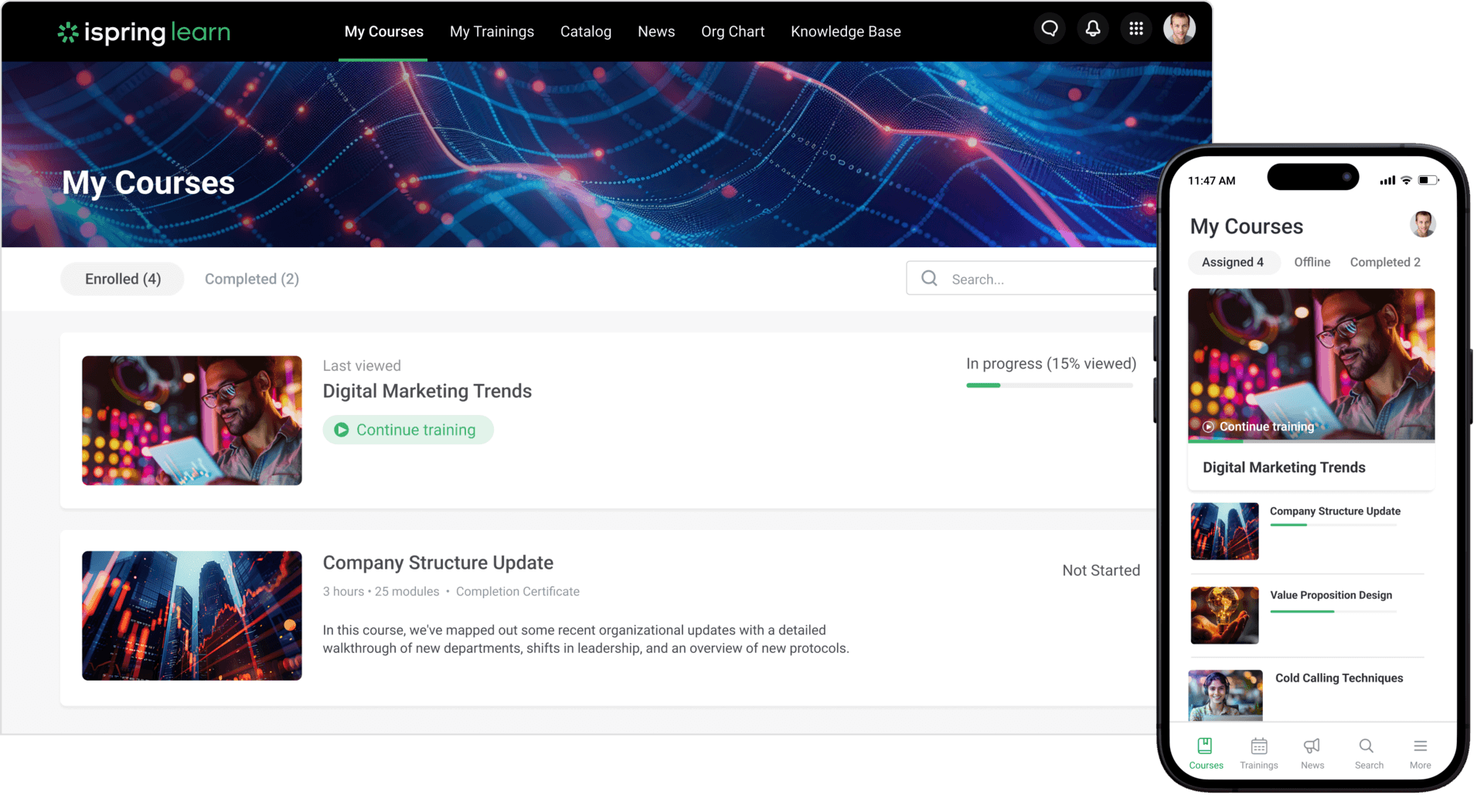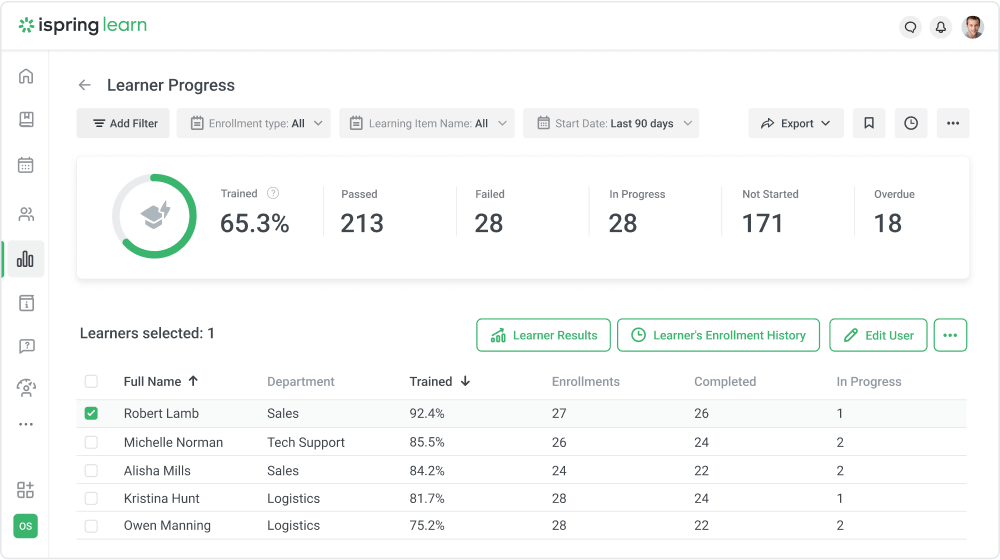Explore Why An LMS Is A Must For Online Training
Online training is more popular than ever, especially after its rise in 2020. During the pandemic, companies have discovered an easier and more cost-effective way to train employees, eliminating the need for travel, venue rental, and lengthy face-to-face sessions. According to a Training Magazine Report, in 2022, almost 90% of US companies used a Learning Management System (LMS) to deliver online courses. However, around 10% of organizations still haven’t made the switch. Let’s find out what’s wrong with manual training delivery and explore what an LMS can offer instead.
Why Manual Training Delivery Is A Thing Of The Past
While organizations have widely embraced online courses for corporate training, some still deliver them manually via email, chat, or cloud storage such as Sharepoint or Dropbox. This presents a number of challenges that can hinder the effectiveness of training programs. Let’s break down just a few.
Administrative Chaos
While manual course sharing may seem convenient at first, it gradually turns learner inboxes or cloud storage into a chaotic mess of multiple folders, links, and materials that are difficult to navigate.
HR or training administrators find themselves overwhelmed with day-to-day tasks such as distributing materials, checking everyone’s access, and ensuring everyone is on the same page. Without centralized control, they also can’t maintain security and consistency as more learners come on board.
Unclear Training Effectiveness
If you don’t have a system to monitor the training process, measuring its success becomes a guessing game. There’s no clear way to tell if learners have completed the training module, how long they’ve been engaged with the material, or if they’re struggling with certain topics. Delivering mandatory compliance training for some highly regulated industries becomes literally impossible.
Training managers also miss out on understanding how the content is resonating. Without tracking engagement and progress, they can’t fine-tune training programs to make them more impactful or enjoyable for learners.
Delayed Communication And Feedback
Two-way communication is an integral part of an effective learning process and is easily achieved with online training platforms. Otherwise, emails and messages can go unanswered for days, leaving learners without any help when they need it most. Trainers are often the last to know when a learner has hit a roadblock and can’t offer immediate support or adapt their materials on the fly.
5 Reasons To Adopt A Learning Management System
If the challenges above sound familiar, or if you’re just thinking about switching to an LMS but don’t fully understand how it can benefit your business, here are some of the key reasons why it’s always a great investment.
1. Better Training Accessibility And Flexibility
First, an LMS is a central hub for all learning content, which means no more searching through emails or different folders for the right documents—all the guides, courses, tutorials, and procedures are always at employees fingertips so they can easily navigate and pick just the right info when they need it.
With a training platform, learners won’t face issues opening files. Plus, some platforms offer native mobile apps, so employees can learn when and where it works for them (on the subway, while waiting in line, or on their journey home), even without an internet connection at all.

2. Seamless Training Management With Minimal Manual Work
Training management is where LMSs really shine, freeing up your time for more critical tasks. Some platforms like iSpring Learn allow you to organize employees into groups and departments to make the enrollment process automatic based on predefined criteria. This means that new hires, for instance, can promptly receive a welcome course without the need for manual intervention from HR or training administrators.
Once you set the rules, the platform keeps learners on track by sending out notifications of course assignments, reminding them of upcoming deadlines, and even letting them know about online meetings scheduled in the LMS built-in calendar.
As your company expands and the number of employees skyrockets, the old “email training” method simply can’t keep up. An LMS, on the other hand, seamlessly adapts to your growing team.
3. Promoting A Learning Culture Among Employees
It may not seem obvious at first, but using an LMS can improve employee loyalty. According to the LinkedIn Workplace Learning Report, L&D opportunities are among the top 5 things people look for in a potential job. And providing them is the number one way companies are working to improve retention.
With an LMS, it’s easier to maintain an atmosphere of continuous learning and development. You can create a catalog of courses available for self-enrollment and upload leadership programs, time management, or public speaking courses so learners can choose what they need and develop job-related skills.
Some platforms, like iSpring Learn, also allow you to create long-term personalized learning paths and assign them to particular employees to prepare them for a promotion or to address their knowledge and skill gaps, such as those identified during a performance review.
4. Data-Driven Approach To Training
With an LMS, you don’t need guesswork or to spend days analyzing learner progress manually—all the data you need is always at hand.
Training platforms provide crystal clear reports on both individual and group progress, so you can see who in the entire department has completed training and passed the final exam. If you wish, you can also drill down to individual progress statistics to determine time spent learning, quiz attempts, and more.

iSpring Learn offers over 20 detailed, customizable reports that help companies monitor every aspect of training. In addition to learner progress reports, the system gathers content statistics that help you identify what works best or needs improvement.
5. More Interactive Training Experience
It goes without saying but is still worth highlighting: learning through an LMS is inherently more interactive. You can vary training methods and test different content formats, from text instructions to presentations to video lectures and podcasts. This versatility not only caters to different learning styles and types of perception but also significantly boosts engagement.
Employees become active participants in the training process. Some platforms allow learners to leave feedback on courses or rate them through stars. With iSpring Learn, they can also communicate with instructors directly in the LMS; for example, asking questions or discussing the topic.
Gamification features such as points for completing courses, badges, and leaderboards create an atmosphere of healthy competition and encourage learners to engage more deeply with the content.
What’s Next?
When choosing a training platform, take this process carefully without rushing into a purchasing decision. If you don’t know where to start, check out a step-by-step guide on how to select an LMS that includes everything you need to know to pick an ideal platform, from analyzing training goals and potential learners to identifying LMS requirements and evaluating vendor proposals. Good luck!
